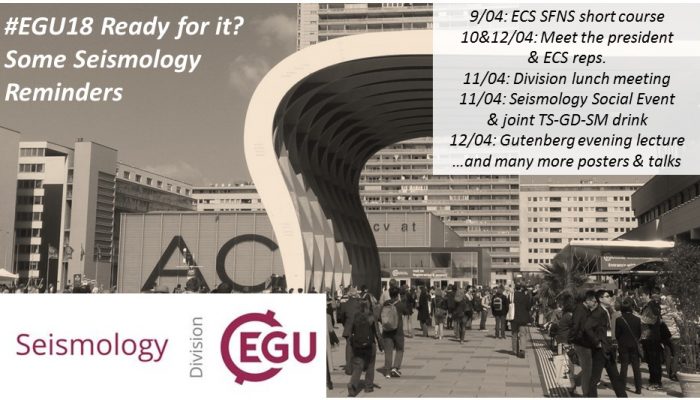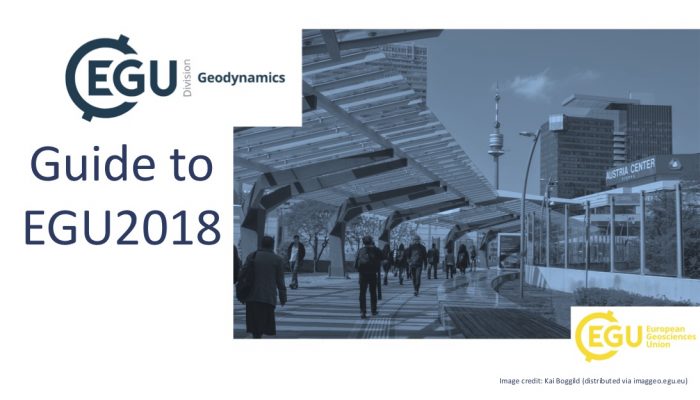Volcanic eruptions are among the fascinating natural phenomena we can observe on Earth. Along with being very attractive, they are hazardous for both society and infrastructures. Eruptive styles are various and today we focus our attention on one particular type of explosive event: hydrothermal eruptions. We have interviewed Cristian Montanaro on the topic.
Geodesy
Review of the General Assembly by the Division President
More than 15.000 participants with great presentations in 666 sessions (posters, PICOs, and orals) made the EGU General Assembly 2018 at the Austrian Convention Centre in Vienna a great success. In the geodesy-led programme, we had 428 submissions, which were distributed to 19 oral blocks, 3 PICO sessions, and a series of poster sessions. We listened to exciting talks, starting with geodetic theor ...[Read More]
Geodynamics
EGU GD Whirlwind Wednesday: Geodynamics 101 & other events
Yesterday (Wednesday, April 12, 2018), the first ever Geodynamics 101 short course at EGU was held. It was inspired by our regular blog series of the same name. I can happily report that it was a success! With at least 60 people attending (admittedly, we didn’t count as we were trying to focus on explaining geodynamics) we had a nicely filled room. Surprisingly, quite some geodynamicists wer ...[Read More]
Geodynamics
EGU GD Informal Lunch
Good afternoon. This is your correspondent, Iris van Zelst, reporting live from the EGU General Assembly 2018 in Vienna, Austria. Today, the first Early Career Scientist Geodynamics event of this week took place. Several young geodynamicists gathered at the Donau Zentrum (metro stop Kagran, 2 stops away from the conference centre) to have lunch. ECS Representative Adina Pusok, who initiated this m ...[Read More]
Geodynamics
Live reporting from EGU GA 2018
As per usual (I mean, we reported Nethermod, right?), the EGU Geodynamics blog team will be reporting live from the 2018 edition of the EGU General Assembly. So, if you cannot attend this year: do not despair! We will keep you in the loop! Look out for updates on the social geodynamics events organised by our ECS GD representative Adina Pusok, interviews with attendees and updates on major session ...[Read More]
Biogeosciences
Welcome to EGU 2018!
Dear all BG members, welcome to EGU 2018! Remember our annual BG Division meeting that will be held on Thursday, April 12, 12:15-13:15 in Room L2. Enclosed the Agenda. This year, the Vladimir Ivanovich Vernadsky Medal of our Division is awarded to Antje Boetius. All invited at the Medal Lecture on Tuesday, April 10, 14:00–15:00 in Room C See you all this evening for the ice breaker at the Opening ...[Read More]
Geomorphology
ECS Events @EGU2018
Finally, the EGU general assembly is starting today. In order to give you some guidance what important events you should definitely not be missing out on, the ECS representatives (Micha Dietze and Annegret Larsen) put together this very nice timetable:
Cryospheric Sciences
Image of the Week – Edible cryosphere at EGU 2018!
It is time again for the annual family meeting of the European Geosciences Union! A lot of interesting talks, posters and events are waiting for you! But this also means you will have to use your brain a lot to concentrate and understand what is going on… Every year, around 15,000 geoscientists meet in Vienna for the EGU General Assembly (see our guide to navigating EGU 2018). It is an exciting ev ...[Read More]
Seismology
Some Seismology reminders for EGU2018 General Assembly
With only 2 days left for the kick off of the annual European Geosciences Union General Assembly (2018), here is a quick-list to go through in time for EGU. First, read this page for information concerning activities for Early Career Scientists at the GA: https://www.egu.eu/young-scientists/at-the-assembly/ EGU2018 mobile app The EGU2018 mobile app is now available. Go to http://app.egu2018.eu to ...[Read More]
Geodynamics
Making the most of the EGU General Assembly 2018 as a Geodynamicist and Early Career Scientist
Are you still deciding on how to best fill your EGU General Assembly program next week in Vienna? Wondering what is on offer specifically for the Geodynamics (GD) early career community? Our EGU GD Early Career Scientist representative, Adina Pusok (Scripps, UC San Diego), shares some planning tips and event highlights for the big week ahead. We are looking forward to seeing you there! The EGU Gen ...[Read More]







